Introducción
The Eight Pieces of Brocade (Bāduànjǐn 八段錦) is one of the most widely practiced series of Qìgōng 氣功 exercises worldwide.
There are numerous versions of these exercises. When discerning whether an exercise is correct or not, one must get rid of the external form and attend to the principles behind it. As different as they may seem, many of these versions are equally correct, since they are based on the same fundamental principles. Instead, there may be seemingly identical versions in form, but which are not being practiced according to such principles.
Qìgōng is based on the so-called "three regulations" (三調 sān tiáo): regulation of the body (調身 tiáo shēn), regulation of the breath (調息 tiáo xī) and regulation of the mind (調心 tiáo xīn).
This means that there must be a control over the body, which is based on the rooting the feet in the earth; a control of the breath (it must follow a specific cycle and must not occur randomly); and a control of the mind, which refers to a tendency to calmness. Likewise, the intention (意 yì), has to guide the energy by focusing on specific regions of the body at certain times.
Anything that does not include these three regulations cannot be considered Qìgōng. This does not mean that gentle gymnastics does not have its benefits, and many people may not be interested in going further, but we believe that, being different things, they should not be confused.

Qìgōng is a very deep art and requires continuous study throughout life. A good instructor must be committed to his own learning, dedicating time to the study and improvement of his knowledge on an ongoing basis.
In this article we want to share some general principles of the practice of Qìgōng, and especially of the Eight Pieces of Brocade or Bāduànjǐn. We do not intend to teach the exercises, and in fact, we will not provide information in this regard, since both movement and breathing and attention are aspects that must be learned directly through a qualified instructor. But we do want to provide relevant information to understand these exercises and know the fundamentals of their practice.
General principles of Qigong practice
Qìgōng is based on Traditional Chinese Medicine (中醫 Zhōng Yī; hereinafter, TCM) theory, which considers that energy (qì 氣) flows through the organism through a series of energy vessels and channels. These channels are divided into 12 principal meridians and 8 extraordinary meridians.
The twelve main channels are associated with the six yīn 陰 organs and six yáng 陽 organs (note that the organs in TCM refer not only to the physical organ, but to a number of related functions).
We are not going to dwell here on the theory of energy channels, as this constitutes a field of study in itself and is beyond the scope of this article.
Qìgōng is mainly based on the stretching of energy meridians, to remove blockages in the channels and facilitate the circulation of qì, and on the opening and decompression of joints and clipping points (points where energy can get stuck). These mechanisms work through the joint action of movement, breathing, and intention.
Intention assists in the conduction of energy. It is said that "where yì (intention) goes, qì follows". Therefore, attentional control is not superficial, the mind has to focus on certain more or less specific points in certain stages of the movement. This helps to connect mind and body (remember that the concept of health in TCM is basically a state of mind-body harmony).
On the other hand, breathing is directly related to the mobilization of qì: some types of breathing are more efficient in the accumulation of energy, while others are more efficient in their mobilization through the channels. As a general rule, when inhaling, qí moves to the limbs, and when exhaling it returns to the dāntián 丹田. However, although breathing should follow a specific cycle, it should not be forced, as excessive attention to breathing can lead to stagnation of qì in the lungs.
Principles of Baduanjin/Eight Pieces of Brocade
Below we will list the exercises that make up the Bāduànjǐn series, explaining their mechanisms of action and the benefits they bring. Note that we refer here to the standing exercises (there is another series of exercises in sitting position, although these are less known and practiced).

Illustration of the Eight Brocade Pieces in a sitting position.
The exercises have a specific order that must be followed, since each one compensates for the deficiencies and excesses of the previous ones. Before starting the series, there is a preparatory position to accumulate energy in the dāntián.
- Both Hands Hold Up the Heavens to Balance the Triple Warmer
雙手托天使三焦 shuāng shǒu tuō tiān shǐ sān jiāo

The first exercise serves to activate the circulation of energy. The Triple Warmer is a TCM organ without a physical correlate, which is related to a series of functions of synthesis and distribution of energy. By raising the hands above the head the muscles and channels of the trunk are stretched; when the arms are lowered, they relax and qì can circulate without obstructions.
- Drawing the Bow to Left and Right Shooting the Vulture
左右開弓似射鵰 zuǒ yòu kāi gōng sì shè diāo
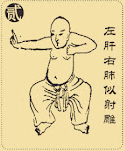 This is an exercise associated with the Lung, which improves respiratory function. The "eight-shape palm" (八字掌 bā zì zhǎng) used on the hand that "holds the bow" causes the stretching of the lung meridian, which ends in the thumb. It also stretches the Large Intestine meridian, which begins at the index finger.
This is an exercise associated with the Lung, which improves respiratory function. The "eight-shape palm" (八字掌 bā zì zhǎng) used on the hand that "holds the bow" causes the stretching of the lung meridian, which ends in the thumb. It also stretches the Large Intestine meridian, which begins at the index finger.
- Separating Heaven and Earth to Balance the Spleen and Stomach
調理脾胃須單舉 tiáo lǐ pí wèi xū dān jǔ
 It improves the functions of the Stomach and Spleen, and promotes digestion, intestinal transit and blood circulation. Helps prevent gastric disorders.
It improves the functions of the Stomach and Spleen, and promotes digestion, intestinal transit and blood circulation. Helps prevent gastric disorders.
The mechanics of the exercise, raising one hand and lowering the other, helps to stretch and distend the muscles of the anterior part of the trunk, as well as the tendons and ligaments of the arms.
The spine must be elongated, decompressing the intervertebral spaces, which helps energy circulate through the Governing Vessel channel (督脈 dū mài).
- Look Back to Prevent the Five Diseases and Seven Injuries
五勞七傷向後瞧 wǔ láo qī shāng xiàng hòu qiáo
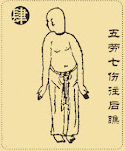 The "five diseases" refer to those related to the five solid viscera and the five hollow viscera (臟腑 zàng fǔ). The "seven injuries" refers to the disharmonies produced by the seven emotions: xǐ喜 (joy, happiness), nù 怒 (anger), yōu 忧 (anxiety, worry), sī 思 (melancholy, desire), bēi 悲 (grief, sadness), kǒng 恐 (fear), jīng 惊 (alarm).
The "five diseases" refer to those related to the five solid viscera and the five hollow viscera (臟腑 zàng fǔ). The "seven injuries" refers to the disharmonies produced by the seven emotions: xǐ喜 (joy, happiness), nù 怒 (anger), yōu 忧 (anxiety, worry), sī 思 (melancholy, desire), bēi 悲 (grief, sadness), kǒng 恐 (fear), jīng 惊 (alarm).
In TCM, it is considered that strong emotions can cause qì to accumulate in the head. This exercise stretches and flexibilizes the cervical muscles, helps eliminate neck stiffness and therefore prevents stagnation of qì in the head and emotional disorders. It also relieves migraines and strengthens the optic nerve.
Some versions of this exercise, such as the one we practice in our school, are also related to the opening of the clipping points in the Governing Vessel channel (dū mài).
- Sway the Head and Shake the Tail to Calm the Heart Fire
搖頭擺尾去心火 yáo tóu bǎi wěi qù xīn huǒ
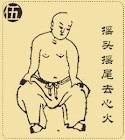 The "heart fire" (心火xīn huǒ) refers to an excess of qì in the middle dāntián, which can be caused by bad habits such as inadequate eating or insufficient rest.
The "heart fire" (心火xīn huǒ) refers to an excess of qì in the middle dāntián, which can be caused by bad habits such as inadequate eating or insufficient rest.
The movement of the trunk, and the position of the hands on the knees, with the thumbs back, cause a widening of the chest distending the lungs, which receive the excess of heart fire and extinguish it through breathing. According to the Five Phase Theory in TCM, the Lung corresponds to the element Metal; Fire dominates Metal, but Metal can also absorb excess Fire and control it.
- Hold the Feet with Both Hands to Strenghten Waist and Kidneys
兩手攀足固腎腰 liǎng shǒu pān zú gù shèn yāo
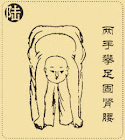 The downward movement of the trunk forward to hold the feet exerts pressure on the kidney area, restricting the flow of qì in the area, and pushing part of the kidney qì to the tailbone penetrating the dū mài channel. By releasing that pressure, the flow is resumed favoring the elimination of blockages, and the qì ascends through the spine invigorating the body.
The downward movement of the trunk forward to hold the feet exerts pressure on the kidney area, restricting the flow of qì in the area, and pushing part of the kidney qì to the tailbone penetrating the dū mài channel. By releasing that pressure, the flow is resumed favoring the elimination of blockages, and the qì ascends through the spine invigorating the body.
On the other hand, when the trunk is lifted forward, pressure is exerted on the first point of the Kidney Channel, K1 Yǒng Quán 湧泉, and when lifting the toes holding the feet that pressure is released, massaging the point and thus favoring the circulation of qì through the Kidney Channel.
The movement of the exercise also stimulates the DM4 point Mìng Mén命門, stretches the entire lumbar, dorsal and cervical muscles and favors blood and lymphatic circulation in the limbs.
By strengthening the Kidney, the ancestral or original qì (元氣 yuán qì), whose root is in the Kidney, is also strengthened and protects the body from diseases.
- Clench the Fists with Angry Eyes to Strengthen the Body
攢拳怒目增氣力 cuán quán nù mù zēng qì lì
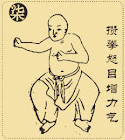 This exercise elevates the spirit and increases vitality. Qì is directed to the limbs, and the energy generated in the previous six exercises is transmitted to muscles and tendons. Strengthens the qì of the Liver, organ that in TCM governs the muscles and which also is connected internally to the eyes.
This exercise elevates the spirit and increases vitality. Qì is directed to the limbs, and the energy generated in the previous six exercises is transmitted to muscles and tendons. Strengthens the qì of the Liver, organ that in TCM governs the muscles and which also is connected internally to the eyes.
- Bouncing on the Toes to Cure Diseases
背后七顛百病消 bèi hòu qī diān bǎi bìng xiāo
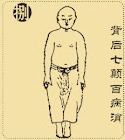 This exercise compensates for the excess of qì that has been accumulated in the upper part of the body during the previous exercises, making it descend and circulate throughout the body. By rising on the toes, the six meridians that connect them with the internal organs are stimulated, balancing the energy in the latter.
This exercise compensates for the excess of qì that has been accumulated in the upper part of the body during the previous exercises, making it descend and circulate throughout the body. By rising on the toes, the six meridians that connect them with the internal organs are stimulated, balancing the energy in the latter.
Final note
It is possible that these exercises entail other benefits, in addition to those we have mentioned, but we have highlighted here those that we consider most important, or what we could say it is the main action of each exercise.
We must remain again that there are many versions of these exercises and that, as long as they follow the fundamental principles of practice, there are no better or more authentic ones than others.
We hope you find this article useful.

6 thoughts on “Principles of Baduanjin Qigong (Eight Pieces of Brocade)”
Thanks for an authentic peek into TCM theory.
Thank you for your appreciation!
I appreciated very much your article. Made every mouvement more clear. Thank you!
Thank you for your comment!
I absolutely love your description of Baduanjin qigong! Thank you for this article!
I took up this practice when I was recovering from a serious back surgery to alleviate my spinal stenosis. My Tai Chi instructor guided me in practicing seated tai chi as I healed. I took up Baduanjin and felt remarkable pain relief and improvement. Even my neurosurgeon commented that whatever I’m doing, it’s working and to keep it up. That was 5 years ago and my practice continues with deepening appreciation for this ancient art.
Hi Kevin,
Thank you so much for your comment. Yours is an inspiring story. We are happy to know that this practice helped you in that way!
Keep it up, and wish you the best.